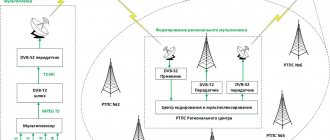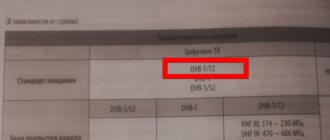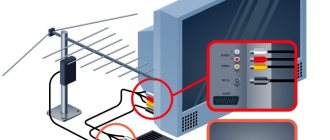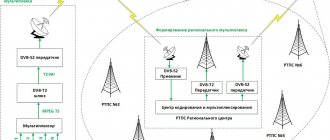The transition from analogue to digital television broadcasting is almost complete. Therefore, it’s time to buy the necessary equipment and set up reception of a new signal format. Now let's look at what frequency digital television broadcasts, what is needed to receive the signal, as well as a few other important questions on this topic. However, let's start with the theory. Let's analyze why the transition to digital is being made at all? Is digital TV really that much better than its predecessor?
What is digital television
Digital TV is a modern television broadcasting technology. The idea is to transmit audio signal and video signal using an appropriate information encoding algorithm. Analogue television is rapidly becoming a thing of the past. This is a logical result. This technology is not capable of broadcasting a stable signal. The number of TV channels is also significantly limited.
A digital signal looks like the best option. Firstly, there is an effective system of protection against all kinds of interference. Secondly, it is possible to transmit audio and video signals in the highest quality. Thirdly, subscribers will be able to set up many different digital channels: federal, entertainment, sports, educational, music, information, etc.
To be convinced of the real need for the transition from analogue to digital broadcasting, let’s consider only the main advantages of the new standard:
- Transmitters with lower power are suitable for signal relay;
- The digital signal is maximally resistant to all kinds of interference;
- High image quality, clear sound;
- Wide selection of available TV channels;
- Possibility of using interactive television systems;
- Additional functions: pause, rewind, record, subtitles;
- Archiving of broadcasts.
These are not all the advantages of digital broadcasting. However, it should be mentioned that there are several digital TV formats, which determine the specifics of the connection.
Digital television formats
In 1993, a digital video broadcasting system was created, also referred to by the abbreviation DVB. Perhaps this is perhaps the most important date in the history of the development and popularization of digital TV. In order to ensure compatibility of equipment and information transmission technology, a special international organization created appropriate standards.
First, let's talk about the standards in which broadcasting takes place. Note that they are classified according to continental characteristics:
- Europe - DVB.
- Asia – ISDB;
- North and South America - ATSC.
Citizens of Russia and other post-Soviet countries use the first, European standard. Absolutely all of the standards presented above are further divided into formats. They determine the specifics of television broadcasting.
It was previously noted that digital TV is closely related to a wide range of various additional services: channels in HD format, pause, rewind, recording, archiving. Providers have the right to charge fees for the use of additional services. Federal TV channels are divided into several multiplexes. In total there are about 30 of them. It all depends on the region. You can tune in these TV channels for free, but you have to pay for the rest.
The European digital TV standard is divided into 4 formats:
- Satellite TV – DVB-S (S2);
- Terrestrial television – DVB-T (T2);
- Cable TV – DVB-C (C2);
- Mobile television – DVB-H (SH).
Abbreviations in brackets indicate the presence of a second generation of the standard.
Volgograd RTRS planned to transfer Volgograd and the region to broadcast digital terrestrial television from the DVB-T standard to the new DVB-T2 by the end of November 2012. But this happened much earlier. On November 20, 2012, digital terrestrial television broadcasting was completely transferred to the new DVB-T2 standard.
Broadcasting of DVB-T standard TV in Volgograd and the region has been completely stopped.
To watch digital terrestrial television of the new standard, you will need DVB-T2 subscriber equipment and a UHF antenna. The first multiplex will be broadcast, consisting of 8 federal television channels and three radio stations. The timing of the competition for broadcasting in the second public multiplex - this is mid-December 2012. Thus, in 2013, viewers will have access (for free) to 20 channels in excellent quality.
The coverage area of digital broadcasting in the DVB-T2 standard includes the entire Volgograd region, including Uryupinsk, Mikhailovka, Kamyshin, Pallasovka and even Elton.
Broadcasting in Volgograd is carried out on 37 TVCs (frequency band - 598.0-606.0 MHz, average frequency - 602.0 MHz).
Broadcasting of digital terrestrial transmitters has begun in 14 settlements in the region, providing citizens with access to modern television. The unofficial transition from analog to digital broadcasting took place on December 27 last year in the cities of Dubovka, Kamyshin and Surovikino, the working village of Elani, the villages of Preobrazhenskaya, Nekhaevskaya, Tishanskaya, Ust-Buzulukskaya, Kletskaya, and the villages of Lyapichev, Deminsky, Uspenka, Tormosin, Tushkanovsky.
All questions you are interested in about CETV broadcasting in Volgograd and the region can be asked at the advisory support center by phone (8442) 34-49-99.
Broadcasting of digital terrestrial television is available in the cities of Dubovka, Kamyshin and Surovikino, the workers' village of Elani, the villages of Preobrazhenskaya, Nekhaevskaya, Tishanskaya, Ust-Buzulukskaya, Kletskaya, the villages of Lyapichev, Deminsky, Uspenka, Tormosin, Tushkanovsky. In Kamyshin , the highest radio-television mast in the Volgograd region is located (height - 332 meters), a 10 kW , which provides television signal coverage to over 220 thousand people in more than 130 settlements right up to the border with Kazakhstan.
1.9/5 — (21 votes)
Also read:
- Launch of digital television in Volgograd
- Second multiplex in Kamyshin
- The second multiplex was launched in the Volgograd region
You can ask questions about digital television on the DVBpro forum
Author: Alexander Vorobyov, 20 Nov 2012 | Permanent link to the page:
Detailed setup
We've sorted out the theory, so it's time to move on to practice. What will users need to set up digital television broadcasting? Conventionally, the whole process can be divided into several stages:
- Determining the location of the repeater (television tower).
- Selecting the optimal method for receiving a digital signal.
- Purchase of necessary equipment.
Let us denote that we are talking about the terrestrial format of digital television broadcasting (DVB-T2). Cable, satellite and mobile TV are connected by the provider, the user does not have to do anything.
How to find out the location of a TV tower
The easiest way to determine the location of the nearest repeater is to use a special map of digital TV coverage in Russia. There are similar maps for other countries: Ukraine, Belarus, Kazakhstan, etc. You can find these cards on the website of the relevant government agency.
Find the search bar, and then enter the name of your locality in it. The relevant information will appear. You will be able to objectively assess the distance to the nearest TV tower.
Note that there are several digital signal reception zones. Reliable reception assumes that the quality of television broadcasting will be maintained at the highest level, regardless of additional factors:
- Solar activity;
- Air temperature and humidity;
- Precipitation, weather conditions;
- Seasons of the year and time of day.
Reliable reception area – coverage within a line of sight radius. The repeater is located as close as possible to your home. There are no obstacles of any kind in the antenna’s path: tall trees, various structures. The map shows absolutely all the towers, even unfinished ones, intended for tuning TV channels from free multiplexes.
Users who are far from the tower are automatically placed in the remote zone. The main problem is that the signal quality decreases. The reason is obvious - the distance from the signal source to the receiver is too large. This issue is being resolved by the state. Active work is underway to build new towers. However, if you are at the edge of the reception area, then it is unlikely that you will be able to avoid various interference associated with a weak signal.
The user will be able to solve the problem independently. It is enough to purchase a special antenna with a complicated design. Your receiver must have maximum gain. In this case, the dimensions of the antenna should be minimal. A directional TV antenna will be the best option.
Digital signal reception options
You can set up digital TV in several effective ways, which differ in signal reception technology. The most obvious option is to connect the cable connected to your TV to a common TV antenna, which is installed in the entrance or on the roof of a multi-story building. An effective way for residents of residential areas. This connection allows you to watch programs, movies and TV series in the highest quality.
Cable providers also broadcast channels in digital format. You can sign up for a paid subscription to get the maximum number of television channels that interest you. Signing an agreement with a cable TV operator will open up a wide range of possibilities for you: broadcast archiving, pause, rewind, etc.
You can also receive a digital signal with a regular TV antenna. The decimeter range will be more than enough. The user’s main task is to point the antenna as accurately as possible in order to receive a clear signal.
Viewing equipment
To set up digital television, you need to have the appropriate equipment. The list of necessary equipment directly depends on the TV used and your place of residence. Modern TV models are equipped with a built-in DVB–T2 tuner. This means that there is no need to purchase a special receiver. How to determine if your TV is equipped with this module? All necessary information is presented in the technical specifications.
If you live in a multi-storey building, then you need to clarify whether it is connected to digital TV? The presence of such a connection will allow you to set up digital television by connecting to a collective antenna.
The choice of equipment should start with the antenna. An ordinary small UHF antenna can provide signal reception. Many analogue antennas are also suitable for receiving digital TV. Therefore, it is likely that you will not have to buy a new device at all. It makes sense to think about purchasing a directional TV antenna, but only if you live quite far from the TV tower. Remember that the location of the TV antenna plays a key role.
An amplifier is another very important device. It is likely that you will be able to do without it. Much depends on the quality of the signal. This issue will be finally resolved after purchasing and installing the antenna. If there is a slight loss of quality, then the amplifier will be a valuable acquisition. This device is mainly used in cases where the user is quite far from the transmitter.
Antennas equipped with broadband amplifiers can significantly improve signal reception for all radio waves with similar frequencies. This may cause problems with signal decoding. Therefore, use the amplifier only in cases where it is really needed.
Stereo amplifier Crestron C2NI-AMP-4X100 economical for 4-16 rooms
Today, users actively use amplifiers with a power of 12 V. However, in accordance with new standards, digital receivers produce a voltage of 5 V. This means that in active television antennas the amplifiers operate on a voltage of 5 V. This is a fairly practical and, most importantly, economical solution . The user does not need an additional power source.
The digital receiver provides signal decoding. Decoders are extremely easy to operate. Devices of this type are configured using a remote control. Many buttons are located on the front panel. Connection to the TV is made through connectors: Video IN, HDMI, RCA, etc. Much depends on the model of TV you are using. Today you can purchase a receiver with additional functionality. Of course, such devices are more expensive.
The last element is cables and wires. The receiver connects to old TVs using a Scart cable. Newer models can be connected via HDMI. The second method is preferable because it is capable of broadcasting images in HD quality. The antenna and receiver must be connected with a coaxial cable, which you can purchase at any radio store.
Antenna and receiver for digital television DVB-T2
Based on standards and frequencies, we come to the conclusion that in Volgograd, to receive digital terrestrial television, you need a DVB-T2 receiver and a UHF antenna.
Selecting an antenna installation location
The best place to install the antenna is the roof of your house. But after a series of events related to the terrorist threat, getting onto the roof of most high-rise buildings is problematic. All doors and hatches are locked. Of course, you can ask for the keys from the housing department, but as a rule this procedure raises questions (or may even be refused) and takes a lot of time.
Therefore, I made an attempt to receive terrestrial digital television using a UHF indoor antenna. So as not to depend on the roof, door locks and housing departments. The difficulty in implementing the task was caused by the fact that the windows of my apartment face the side of the house opposite from the nearest television tower. The distance from the house to the tower is about 5 km (I live in the southernmost area of the city). Receiving digital television in this situation using an indoor UHF antenna may seem impossible. But I will prove that this is not at all true.
A simple UHF television antenna for receiving DVB-T2 digital television in Volgograd
There are a great variety of decimeter antennas that you can make yourself. And if you immediately abandon the idea of making a “wave channel”, then all other antennas can be considered simple











